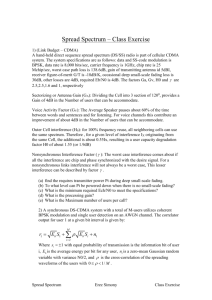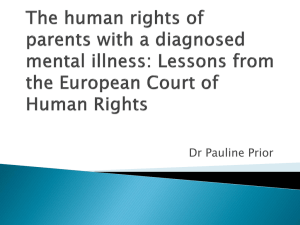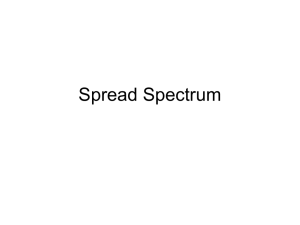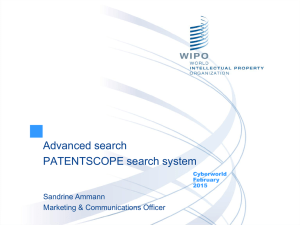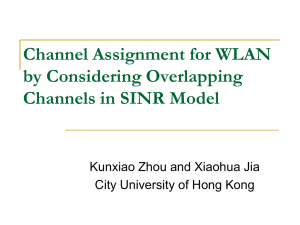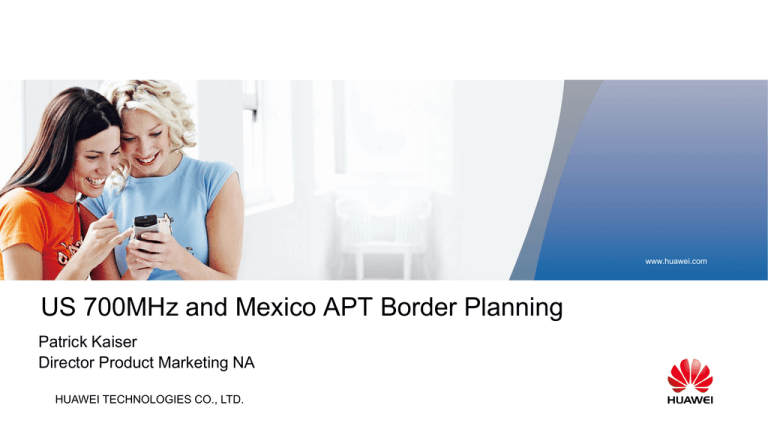
www.huawei.com
US 700MHz and Mexico APT Border Planning
Patrick Kaiser
Director Product Marketing NA
HUAWEI TECHNOLOGIES CO., LTD.
Benefits of 700Mhz APT Spectrum Plan
Key Benefits of 700 APT Plan
US plan
2 times the capacity in 15MHz compared to typical
10MHz bandwidth providing critical capacity as MBB
quickly grows
Smartphones have increased business costs. Larger
economies of scale promotes lower device costs.
Dedicated capacity on demand rather than dedicated
spectrum contributes to greater capacity on average
Traffic is Booming
Mobile
Business
MBB: 19x
Web / Email
P2P
APT plan
Global economies of scale –
lower handset costs, simplified
roaming
400 million users 4 billion users
Amount of spectrum
harmonised for large scale
commercial use
37 per cent
83 per cent
Amount of spectrum dedicated
16% dedicated
to public safety and connectivity
spectrum
model
0%, spectrum not
dedicated (capacity
guaranteed)
Number of 2 x 10/2 x 15 MHz
2/0
networks that can be supported
4/3
Cost of covering the entire
population
$150 million
$800 million
Minimum time it will take to
deploy a network covering the 2.5 years
entire population of Mexico City
1.5 years
Video
Characteristics of the two segmentation models for the 700 MHz band
2010
2011
2012
2013
2014
2015
2016
HUAWEI TECHNOLOGIES CO., LTD.
Reference Source: Cofetel
Page 2
US-Mexico Border Spectrum Coordination Challenges
9MHz guard band provides
cleaner 10MHz block
15MHz carrier would
overlap with SDL
Scenario1a,b
UL
DL
Guard gap:
16M
DL
10M:verizon
DL
Guard band
9M
DL
10M:ATT/VZW
UL
scenario2
scenario2
Scenario1a,b
UL
Greater challenge because of the
overlap of DL/UL inter-systems
Scenario1a,b US
Public Safety
Challenge
UL
UL
DL
Scenario1a: BS-BS Inter-channel interference – BS1 TX overlaps BS2 RX, most challenging. Requires separation distance at key cites (ex. San Diego-Tijuana),
sharper BS filter, careful RNP. Will require detailed regulatory coordination in transition zone. Lower 10MHz will have lower interference due to 16/9MHz guard bands.
Scenario1b: UE-UE Inter-channel interference – UE1 TX overlaps UE2 RX. Coordination is probabilistic (close proximity of UE1-UE2) and difficult to control.
Scenario2: BS-UE inter-channel interference, channel of BS1 TX overlaps UE RX. Usually covered by existing treaties. Similar scenario as inter-technology
interference. Requires traditional RNP. Interference to BS1 RX from UE2 TX usually considered negligible due to low TX power of UE. Similar to scenario1a.
Scenario3: Interference from DTV51 significantly reduced due to 5MHz guard band.
Scenario4: Spectrum in US currently owned by ATT, broadcast only, commercial plans unknown. Will likely require regulatory coordination.
HUAWEI TECHNOLOGIES CO., LTD.
Page 3
US-Mexico Border Spectrum Interference Mitigation Options
Antenna
Down Tilt
Antenna
Down Tilt
Added BS Filtering*
*Not beneficial for co-channel
interference.
macro
macro
Small(er)
cell
Small(er)
cell
Vs.
Coordinated antenna orientation can substantially
reduce interference as a lower cost option
Required 90dB isolation for lower 10MHz block can
be obtained with <1km ISD (54km if direct line-of-site)
HUAWEI TECHNOLOGIES CO., LTD.
Mitigation Options
Small/smaller cells (reduced BS TX levels) within buffer zone
operate at lower power levels as will UE. Required on both sides.
RNP options
Down tilt of antennas facing away from border reduce cell size and
interference
Orientation of antenna main load and back lobes reduce interference
Consider restriction to lower 10MHz block near key cities (SD-Tijuana)
reducing buffer zone to ~54km
Added TX/RX BS filtering can improve BS-BS Inter-channel
interference
RNP restrictions unnecessary past ~60-70km inter-site buffer zone.
Will make US 700MHz plan difficult in smaller LA countries
Page 4
Thank you
www.huawei.com
Copyright©2011 Huawei Technologies Co., Ltd. All Rights Reserved.
The information contained in this document is for reference purpose only, and is subject to
change or withdrawal according to specific customer requirements and conditions.


